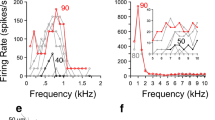Summary
-
1.
The H cell is an unpaired neuron originating in subganglion 3 of the subesophageal ganglion. Its processes form an ‘H’ with long axis on the midline of the nervous system (Fig. 1). The soma is off-center, originating from the junction of the main neurite (the crossbar of the ‘H’) and one or the other axon (upright of the ‘H’).
-
2.
Illuminating any eye excites the H cell, producing a volley of impulses riding on a compound synaptic potential. The synaptic potential is graded with light intensity and it persists in 40 mmol/l Mg saline (Fig. 3).
-
3.
Touching the skin inhibits the H cell by a polysynaptic pathway that includes the mechanosensory T cells (Fig. 4).
-
4.
The H cell has two impulse initiation sites, one in each axon. Impulses in the axon ipsilateral to the soma cause large spikes in the soma; those in the other axon cause small spikes (Fig. 2).
-
5.
Large spikes match synaptic potentials in the AV (anterior visual) cell ipsilateral to the soma of the H cell (Figs. 5, 6); small spikes match synaptic potentials in the contralateral AV cell.
-
6.
This synaptic potential has a large inhibitory component and a small excitatory component (Fig. 7). The inhibitory component is caused by an increase in Cl conductance (Figs. 7, 8); the excitatory component may be electrical (Fig. 9).
-
7.
The connection between the H cell and the AV cell may be polysynaptic since it is blocked by high Ca/Mg saline (Fig. 9).
Similar content being viewed by others
References
Bate M, Goodman CS, Spitzer NC (1981) Embryonic development of identified neurons: segment-specific differences in the H cell homologues. J Neurosci 1:103–106
Blair SB (1983) Blastomere ablation and the developmental origin of identified monoamine-containing neurons in the leech. Dev Biol 95:65–72
Calabrese RL (1979) The roles of endogenous membrane properties and synaptic interaction in generating the heartbeat rhythm of the leech,Hirudo medicinalis. J Exp Biol 82:163–176
Fernandez J, Stent GS (1982) Embryonic development of the hirudinid leechHirudo medicinalis: structure, development and segmentation of the germinal plate. J Embryol Exp Morphol 72:71–96
Frank E, Jansen JKS, Rinvik E (1975) A multisomatic axon in the central nervous system of the leech. J Comp Neurol 159:1–13
Gardner-Medwin AR, Jansen JKS, Taxt T (1973) The ‘giant’ axon of the leech. Acta Physiol Scand 87:30A-31A
Goodman CS, Bate M, Spitzer NC (1981) Embryonic development of identified neurons: origin and transformation of the H cell. J Neurosci 1:94–102
Jansen JKS, Muller KJ, Nicholls JG (1974) Persistent modification of synaptic interactions between sensory and motor nerve cells following discrete lesions in the central nervous system of the leech. J Physiol (Lond) 242:289–305
Mann KH (1962) Leeches (Hirudinea). Their structure, physiology, ecology and embryology. Pergamon Press, New York
Muller KJ, Nicholls J, Stent GS (1981) The neurobiology of the leech. Cold Spring Harbor Laboratory, Cold Spring Harbor, NY
Muller KJ, Scott SA (1981) Transmission at a ‘direct’ electrical connexion mediated by an interneuron in the leech. J Physiol (Lond) 311:565–583
Nicholls JG, Baylor DA (1968) Specific modalities and receptive fields of sensory neurons in the CNS of the leech. J Neurophysiol 31:740–756
Nicholls JG, Purves D (1970) Monosynaptic chemical and electrical connexions between sensory and motor cells in the central nervous system of the leech. J Physiol (Lond) 209:647–667
Nicholls JG, Wallace BG (1978) Modulation of transmission at an inhibitory synapse in the central nervous system of the leech. J Physiol (Lond) 281:157–170
Oertel D, Stuart AE (1981) Transformation of signals by interneurones in the barnacle's visual pathway. J Physiol (Lond) 311:127–146
Peterson EL (1983) Visual processing in the central nervous system of the leech. Nature 303:240–242
Peterson EL (1984a) The fast conducting system of the leech: a network of 93 dye-coupled interneurons. J Comp Physiol A 154:781–788
Peterson EL (1984b) Photoreceptors and visual interneurons in the leech. J Neurobiol 15:413–428
Peterson EL (1985a) Visual interneurons in the leech brain: I. Lateral visual cells in the subesophageal ganglion. J Comp Physiol A 156:697–706
Peterson EL (1985b) Visual interneurons in the leech brain: II. The anterior visual cells of the supraesophageal ganglion. J Comp Physiol A 156:707–717
Stewart W (1978) Intracellular marking of neurons with a highly fluorescent naphthalimide dye. Cell 14:741–747
Weeks JC (1981) Neuronal basis of leech swimming: separation of swim initiation, pattern generation, and intersegmental coordination by selective lesions. J Neurophysiol 45:698–723
Weeks JC (1982) Synaptic basis of swim initiation in the leech. II. A pattern-generating neuron (cell 208) which mediates motor effects of swim-initiating neurons. J Comp Physiol 148:265–279
Weeks JC, Kristan WB Jr (1978) Initiation, maintenance and modulation of swimming in the medicinal leech by the activity of a single neurone. J Exp Biol 77:71–88
Weisblat DA, Harper G, Stent GS (1980) Embryonic cell lineages in the nervous system of the glossiphoniid leechHelobdella triserialis. Dev Biol 76:58–78
Yau K-W (1976) Physiological properties and receptive fields of mechanosensory neurons in the head ganglion of the leech: comparison with homologous cells in segmental ganglia. J Physiol (Lond) 263:489–512
Author information
Authors and Affiliations
Rights and permissions
About this article
Cite this article
Peterson, E.L. Visual interneurons in the leech brain. J. Comp. Physiol. 156, 719–727 (1985). https://doi.org/10.1007/BF00619121
Accepted:
Issue Date:
DOI: https://doi.org/10.1007/BF00619121




